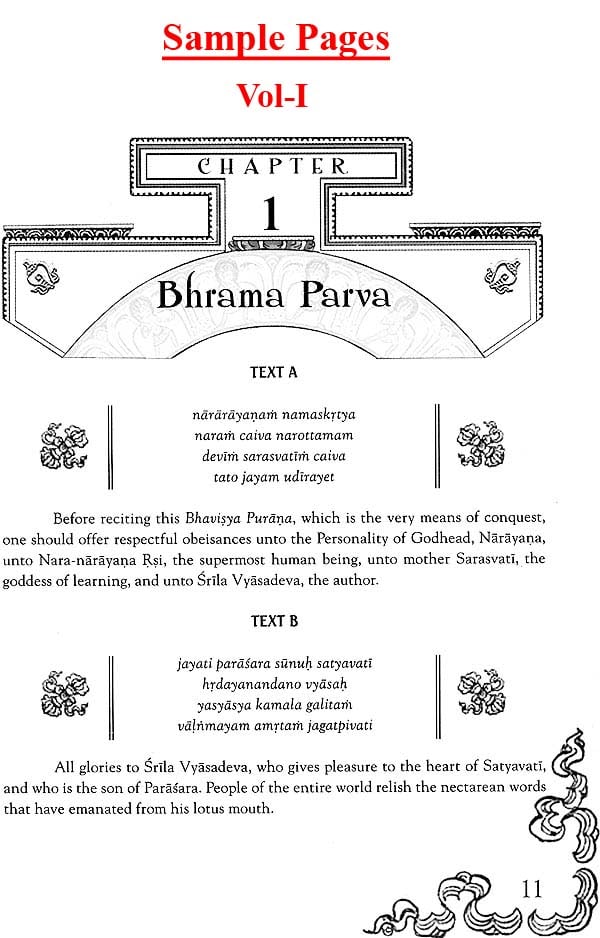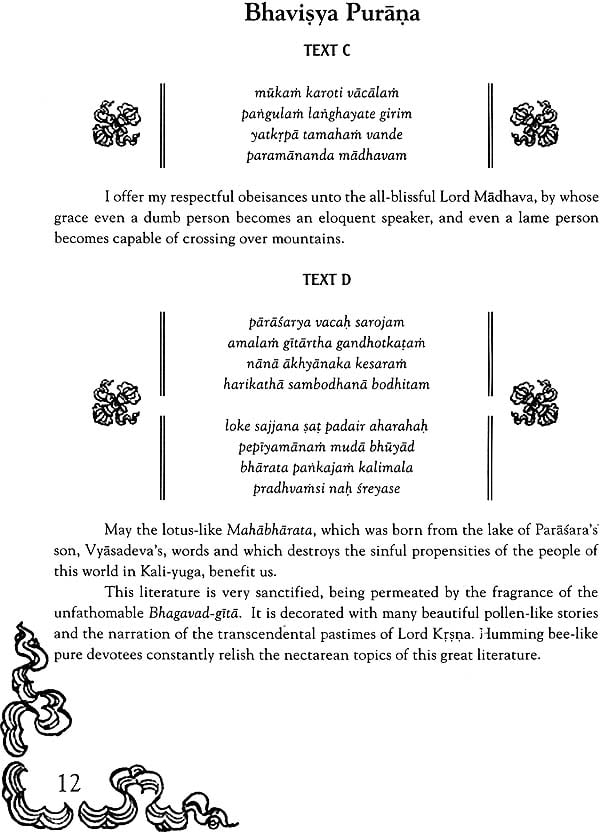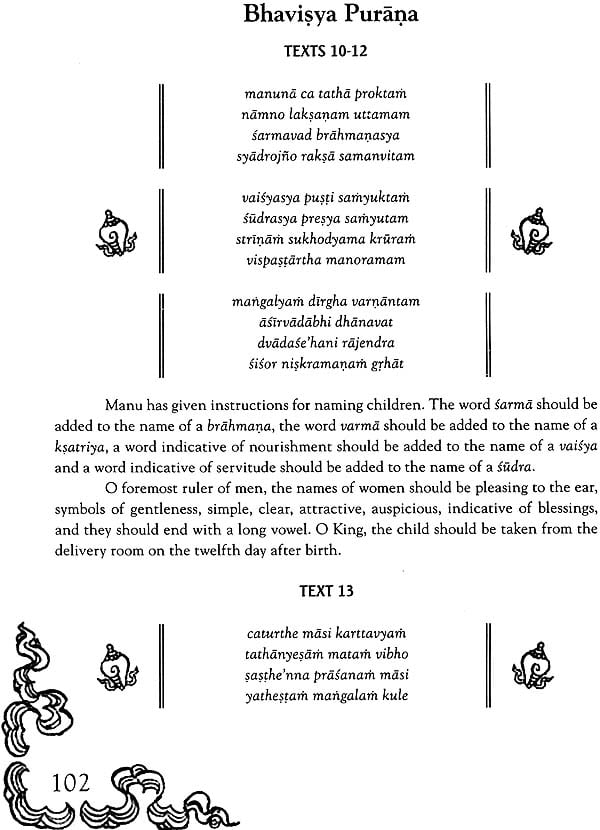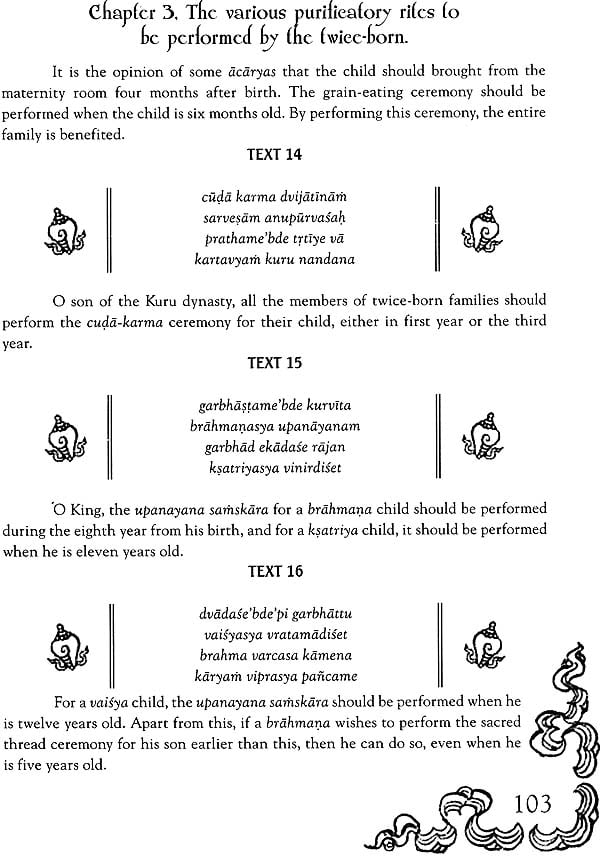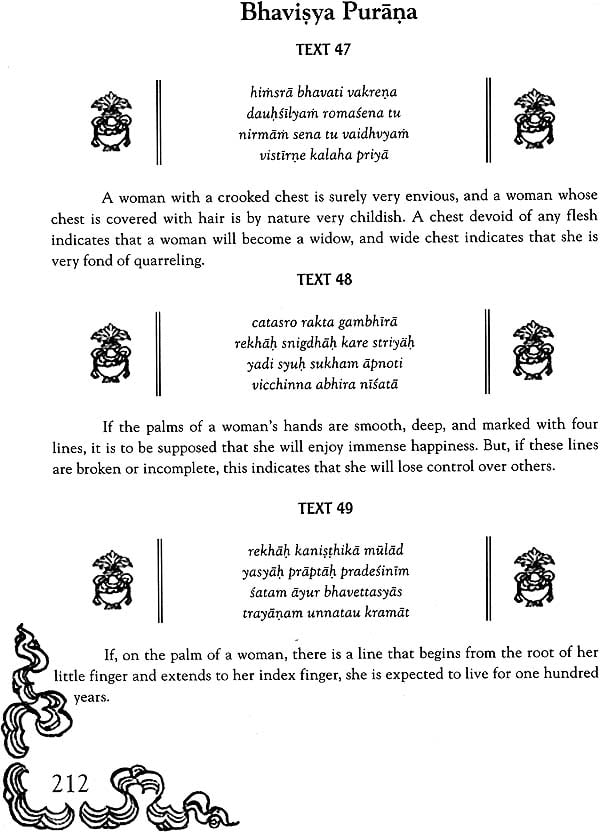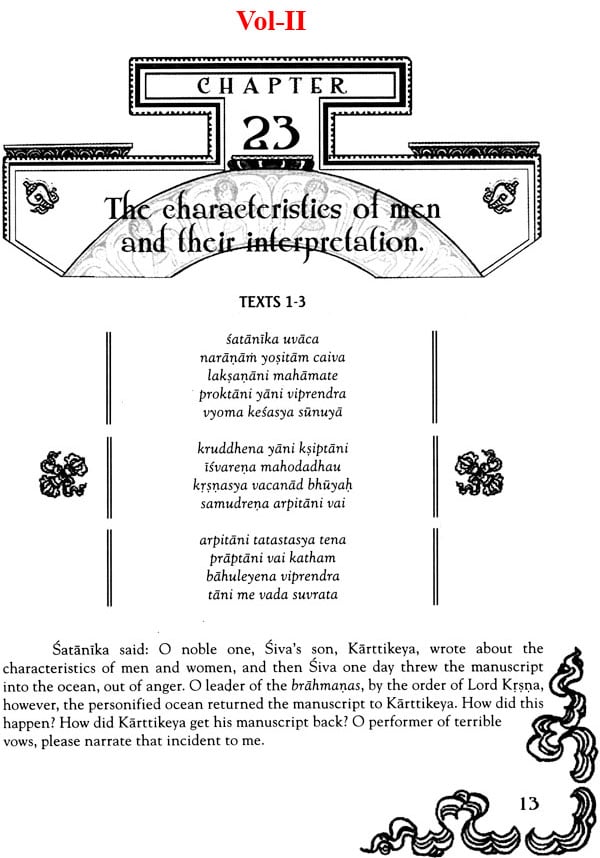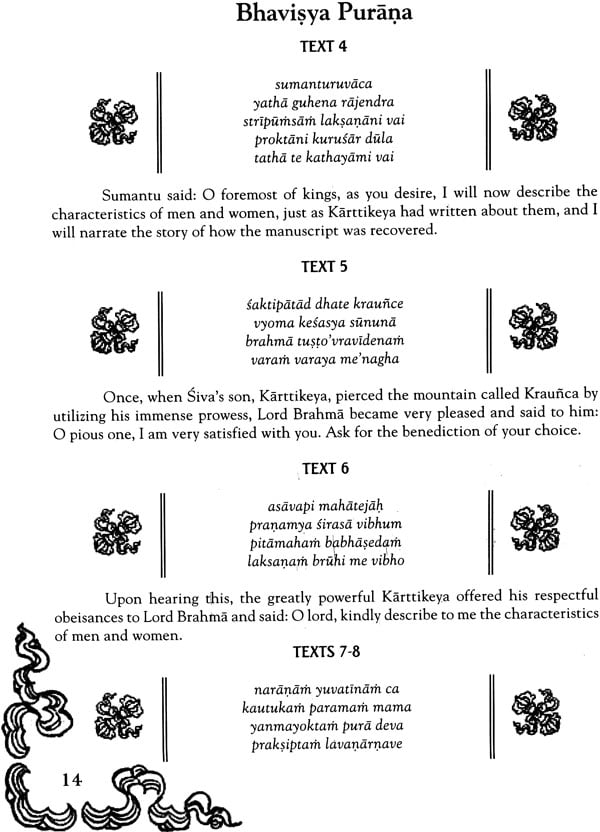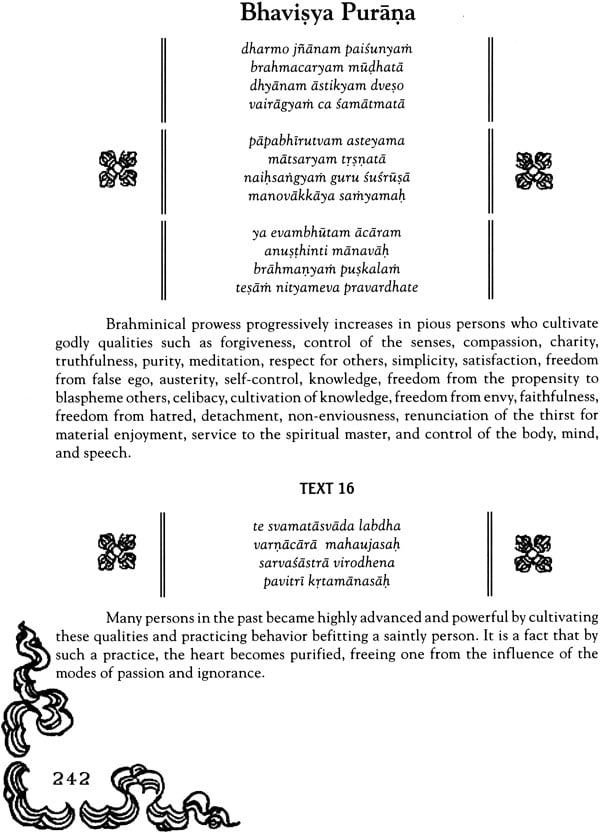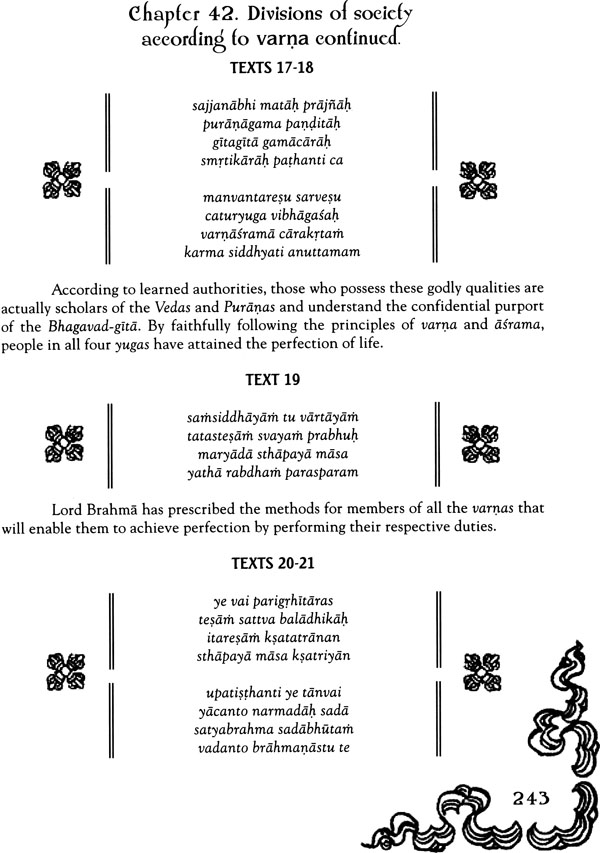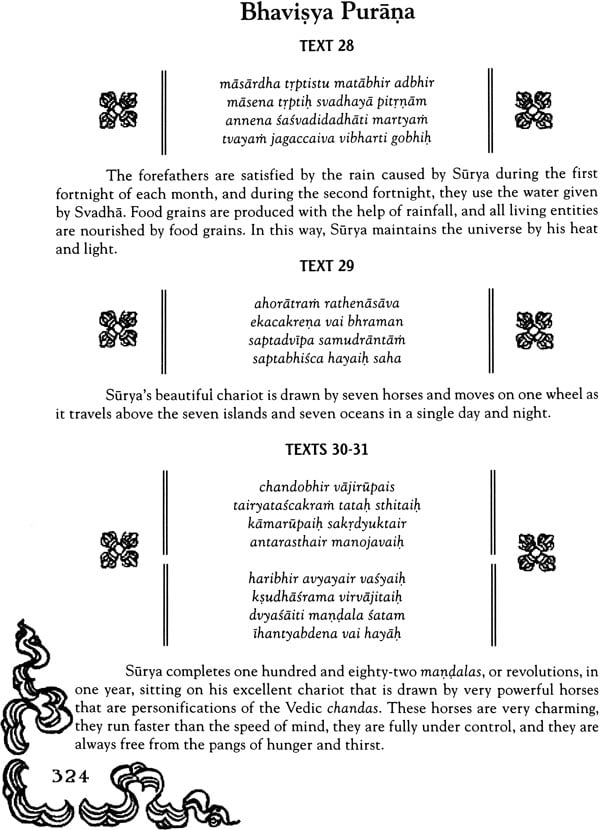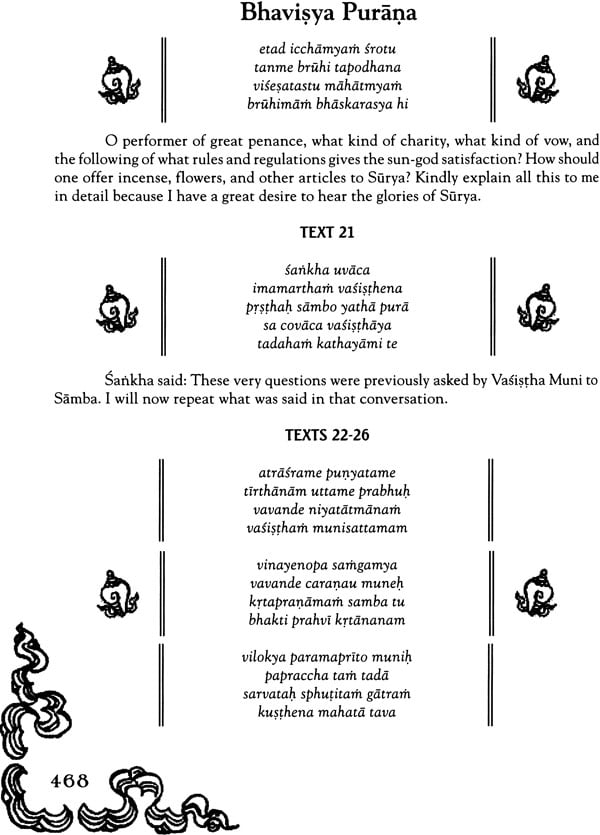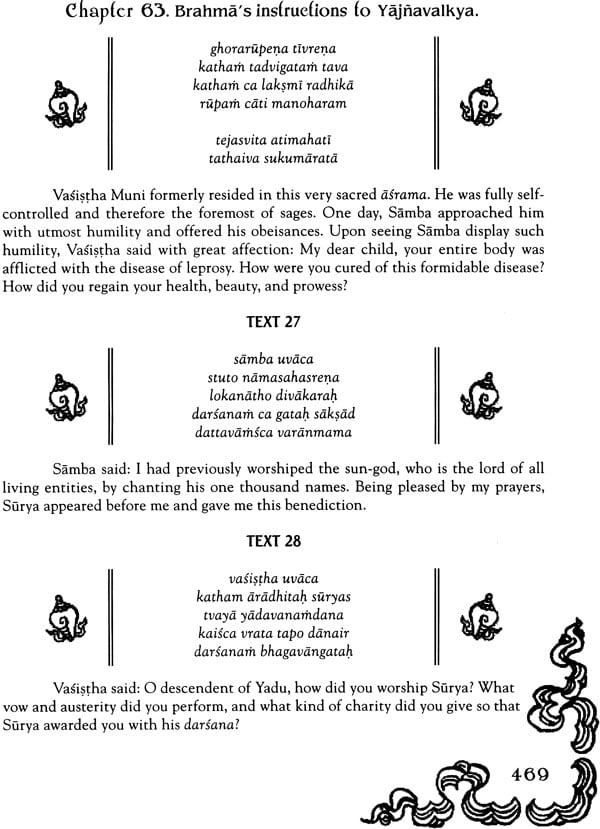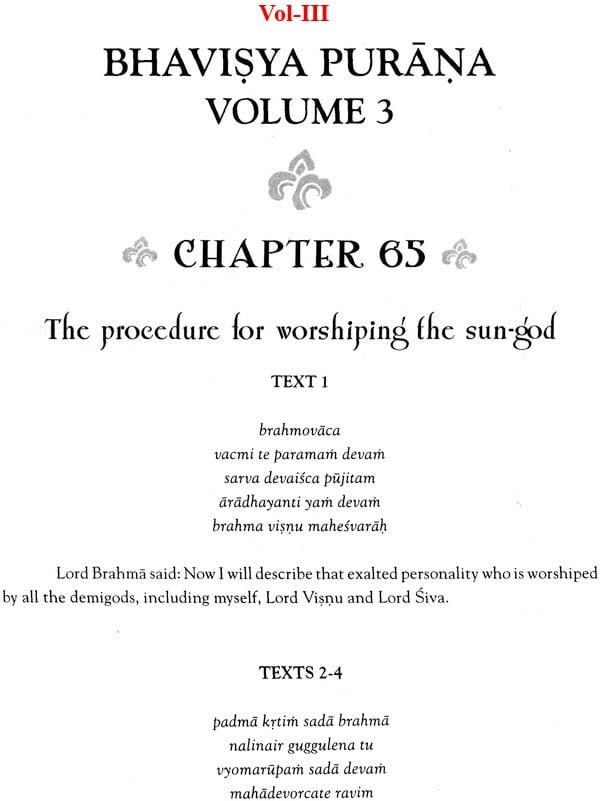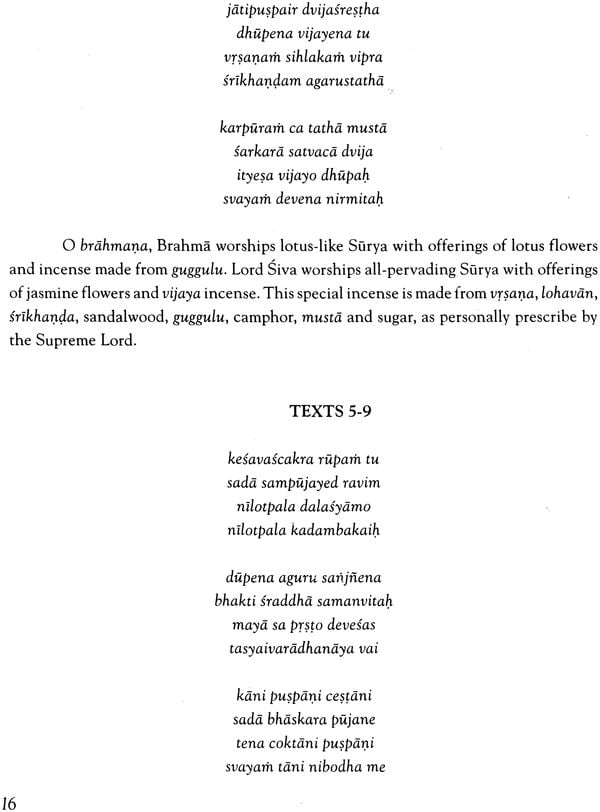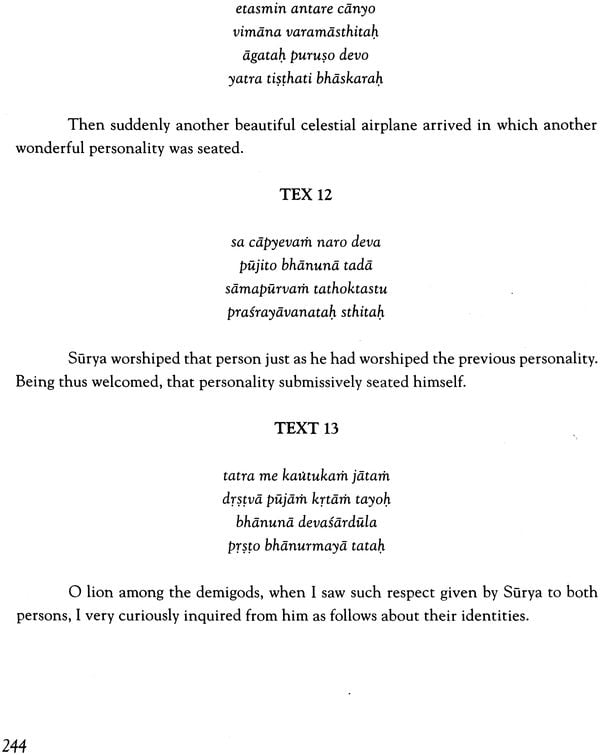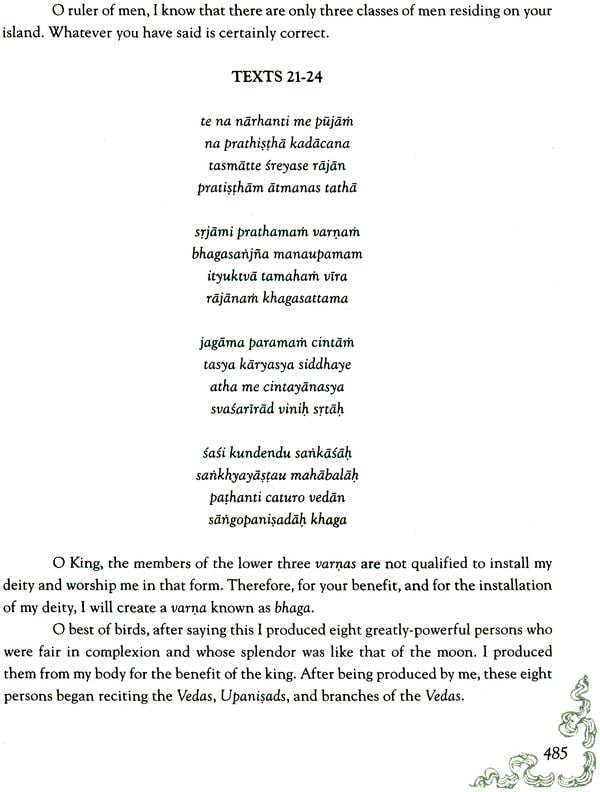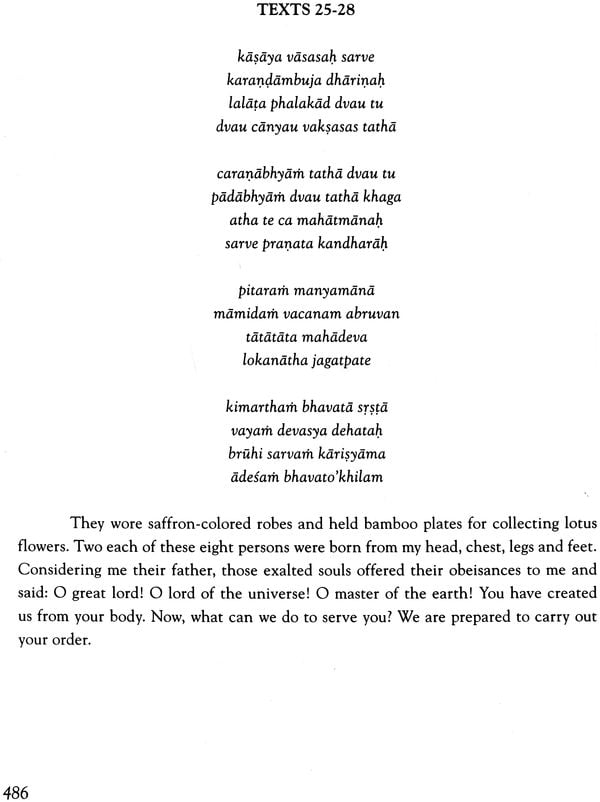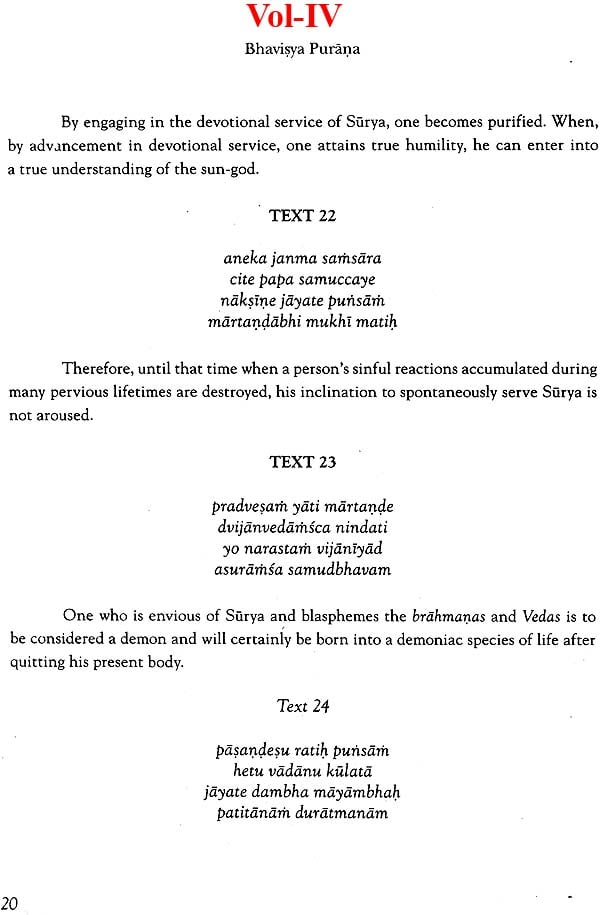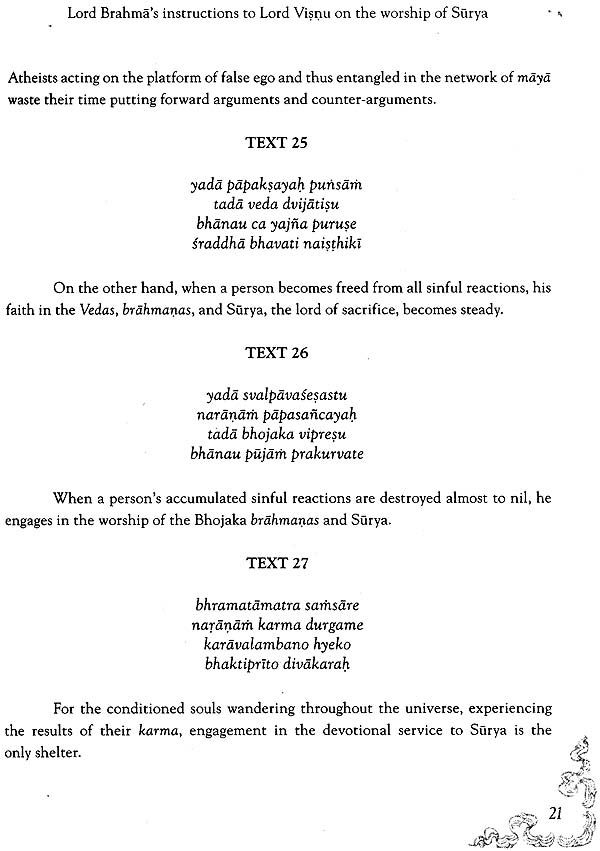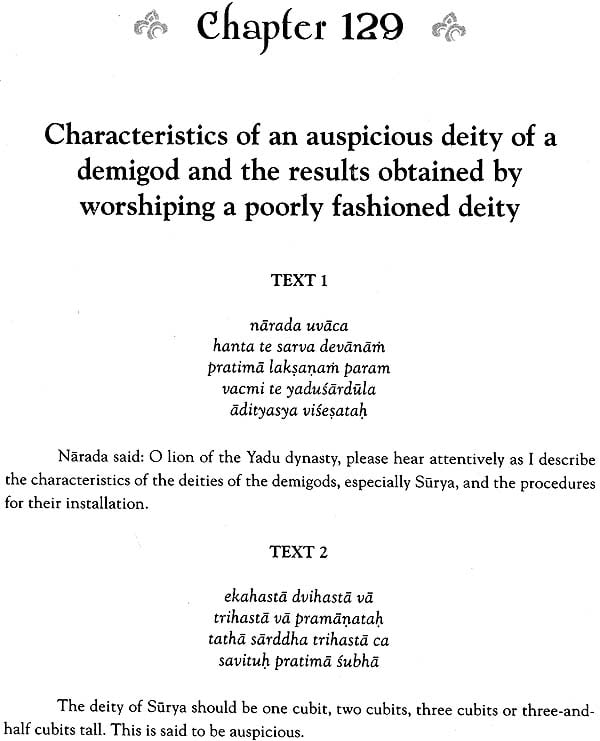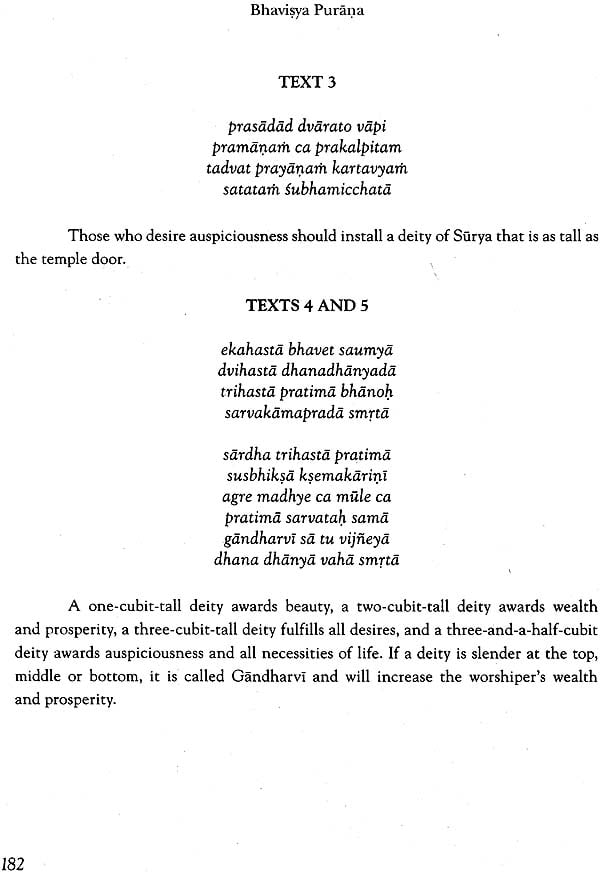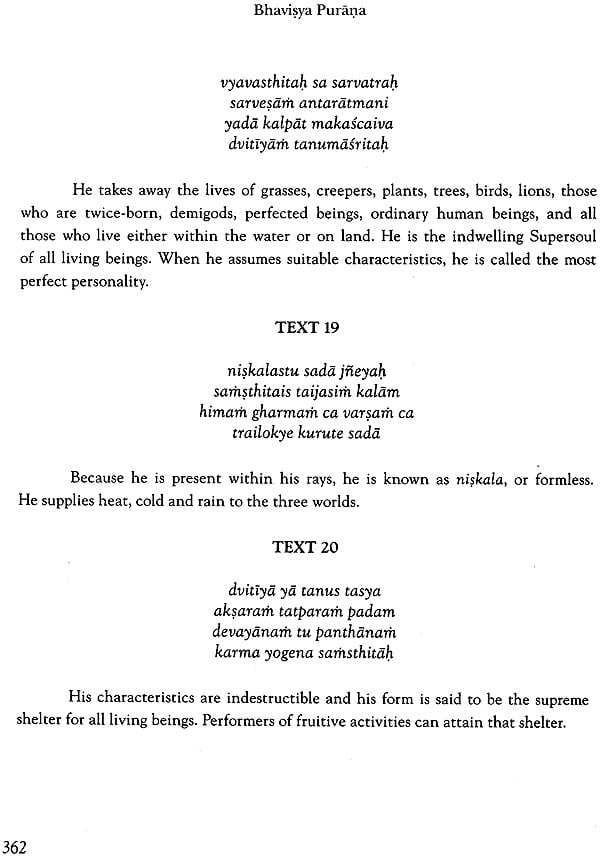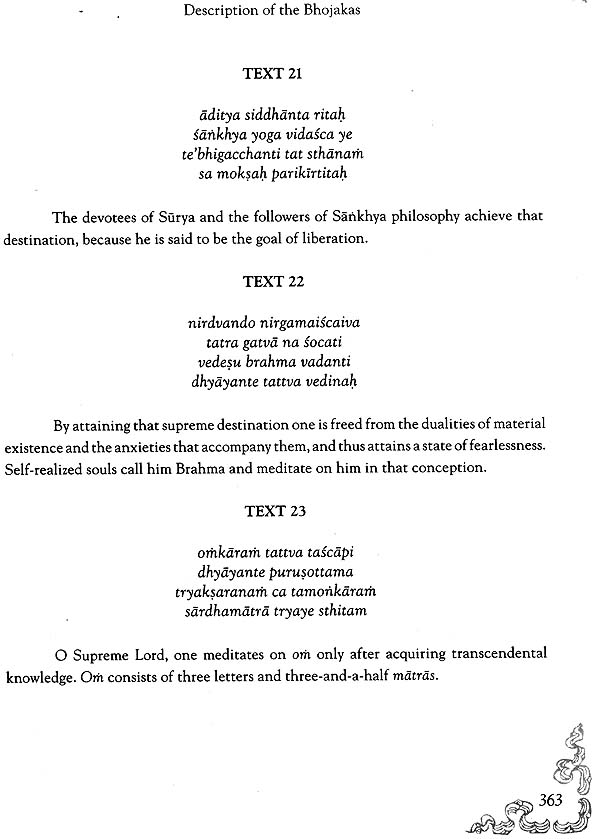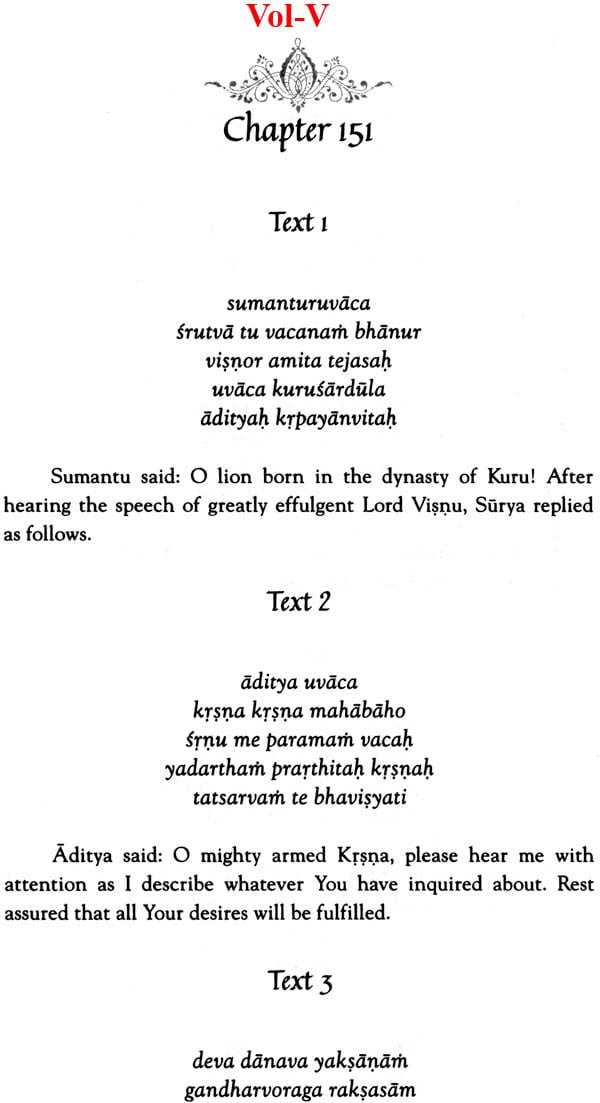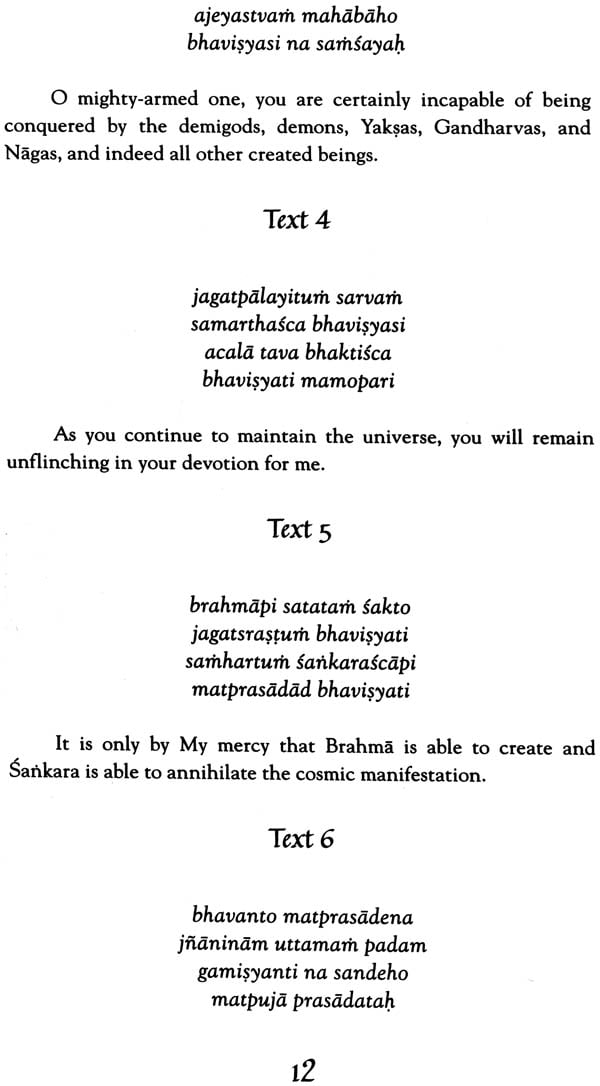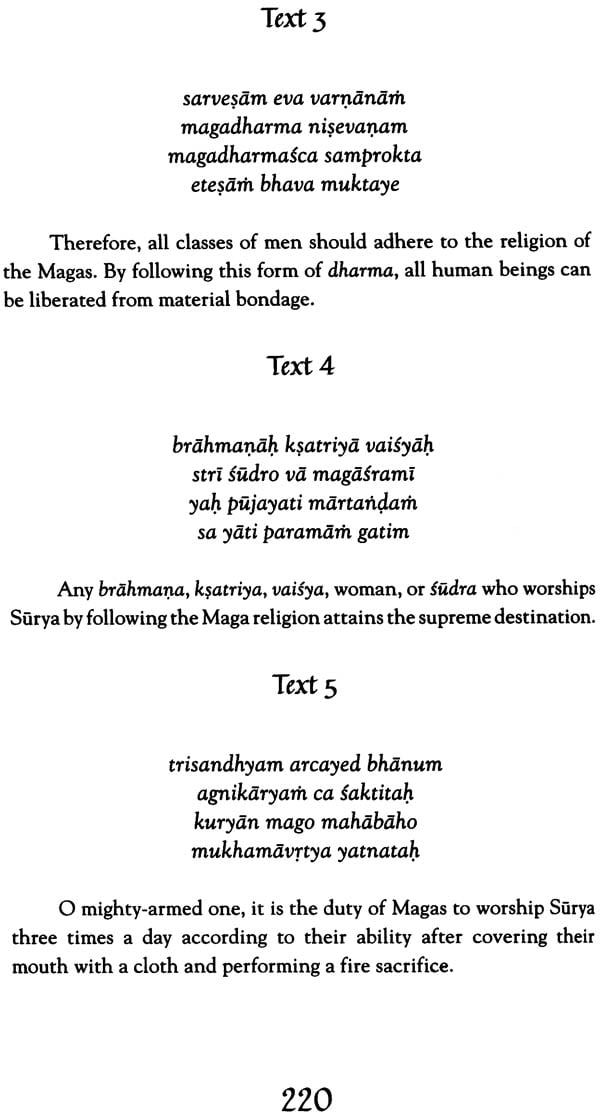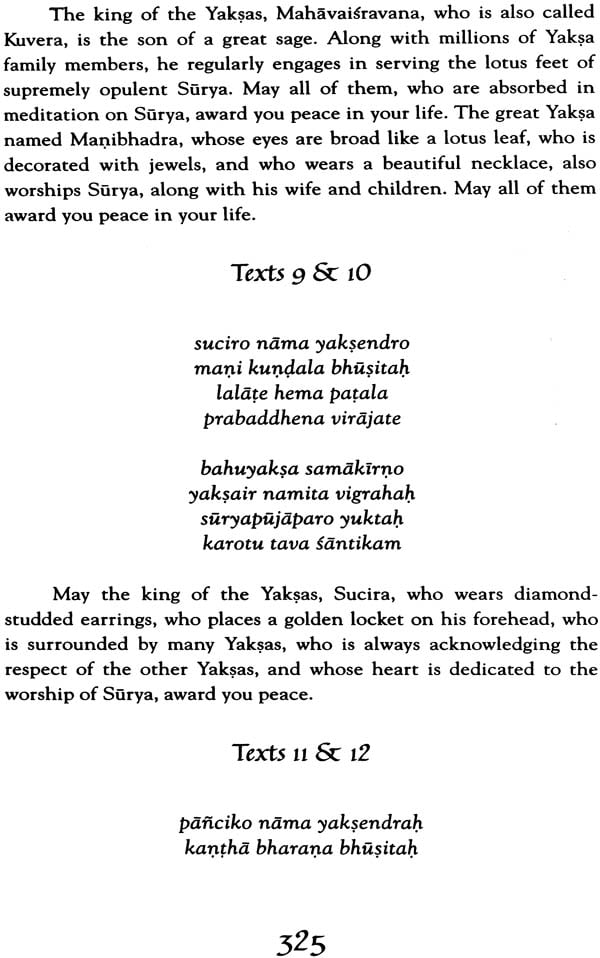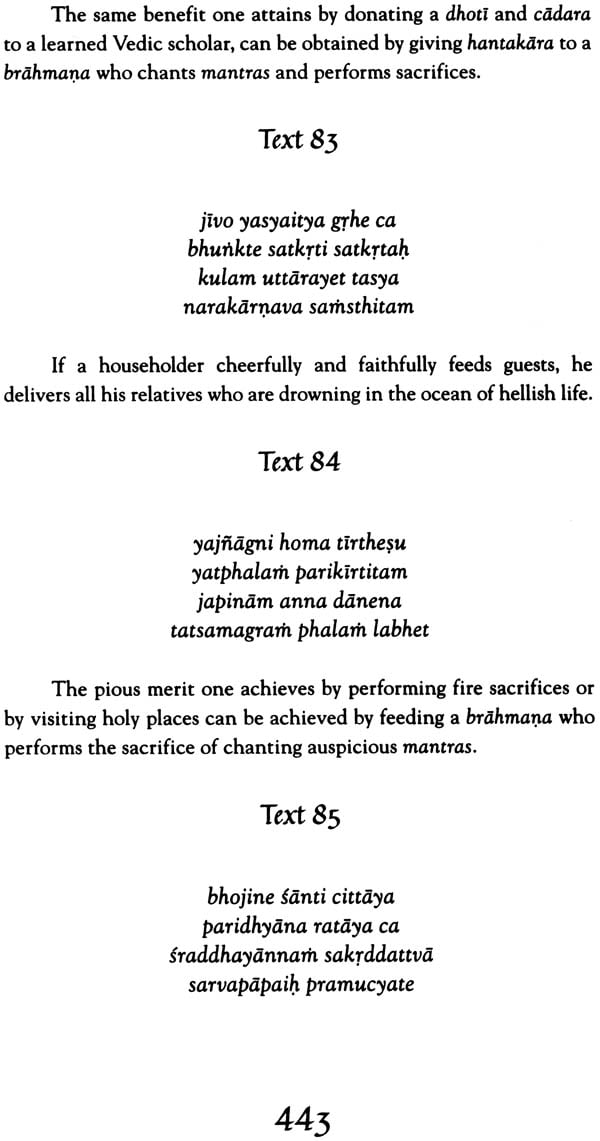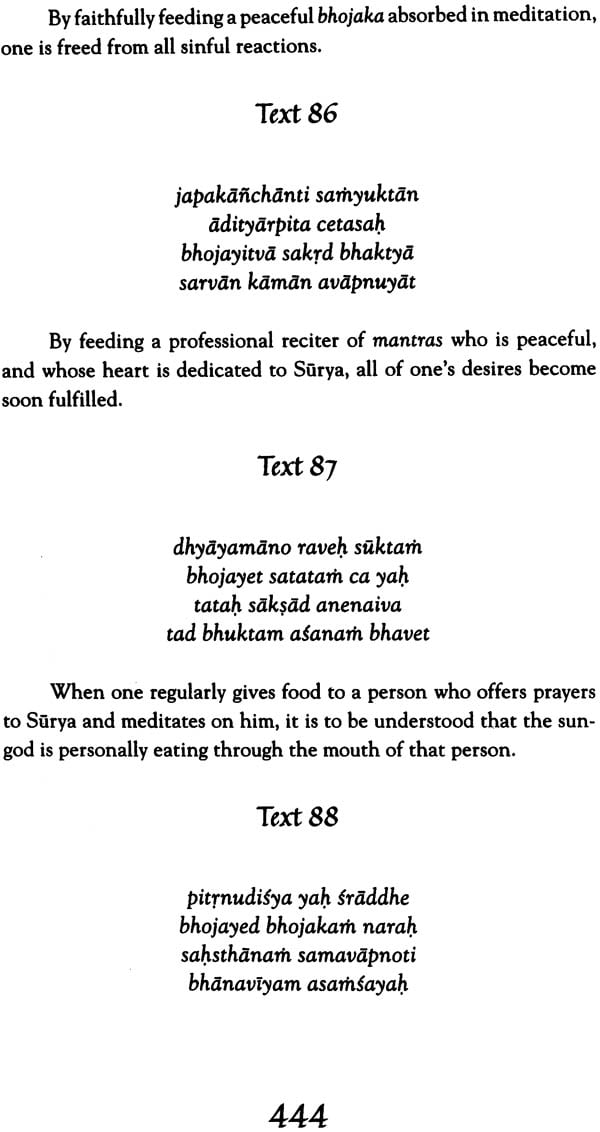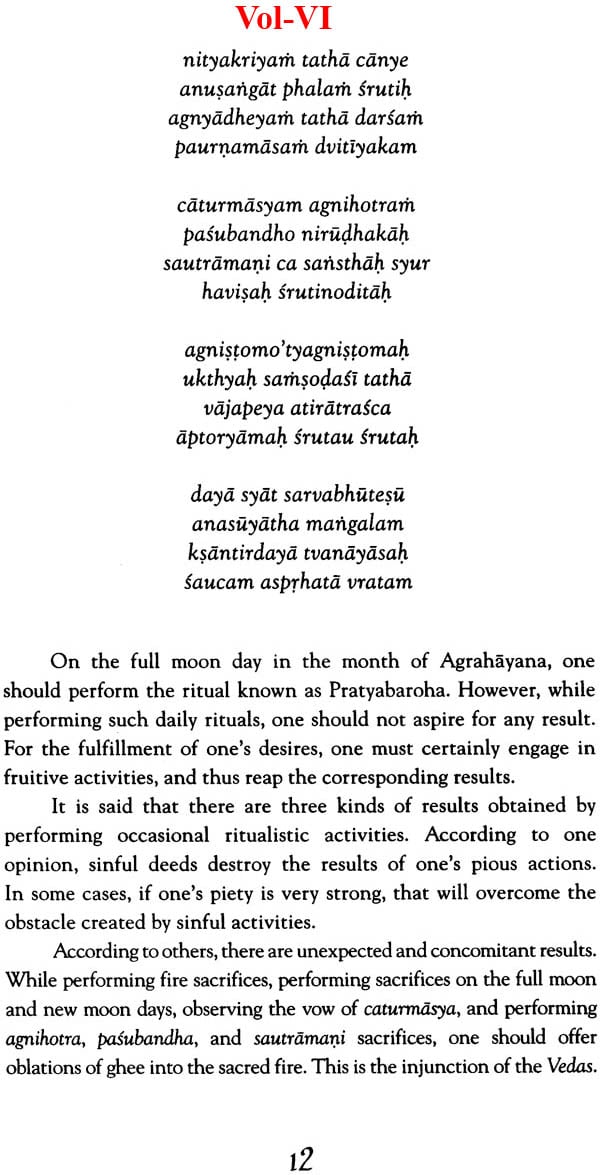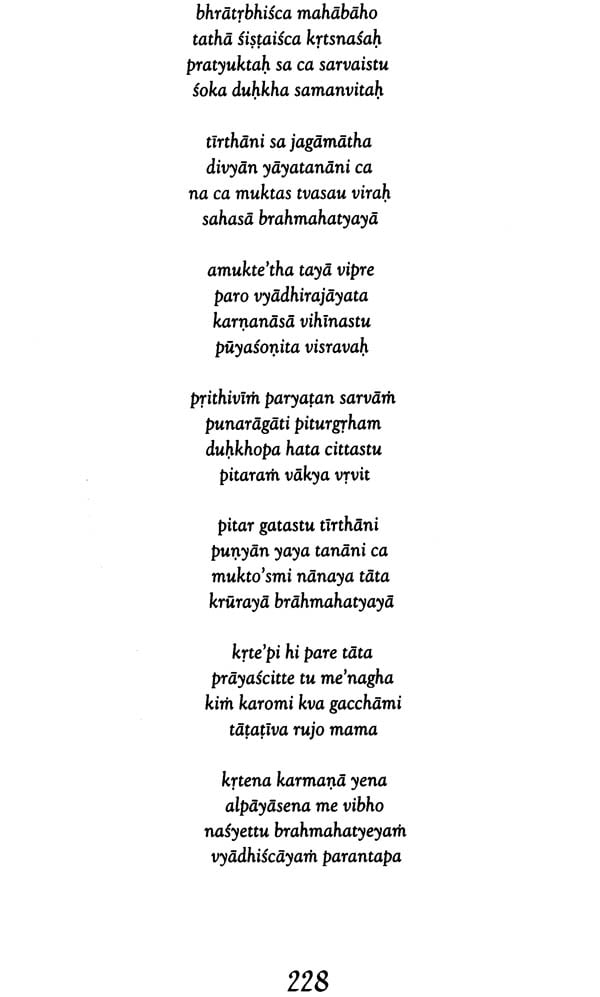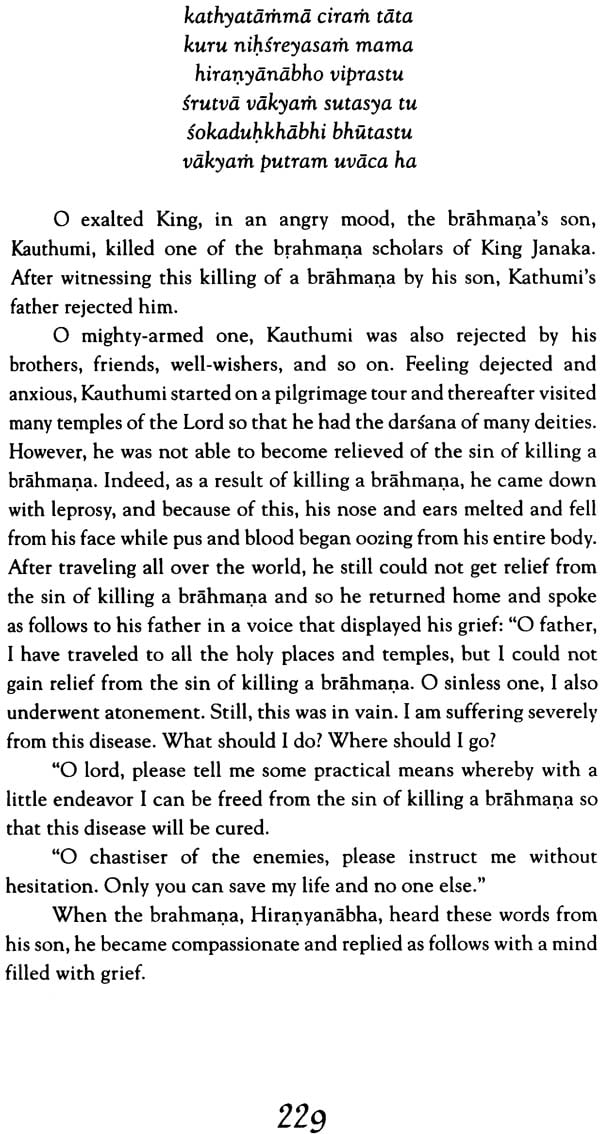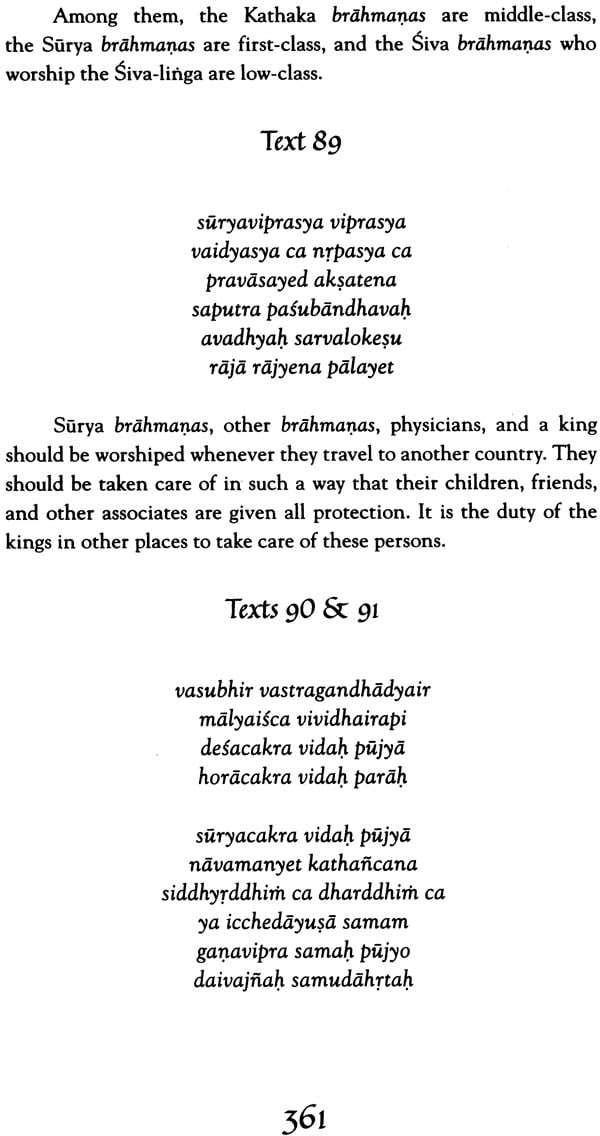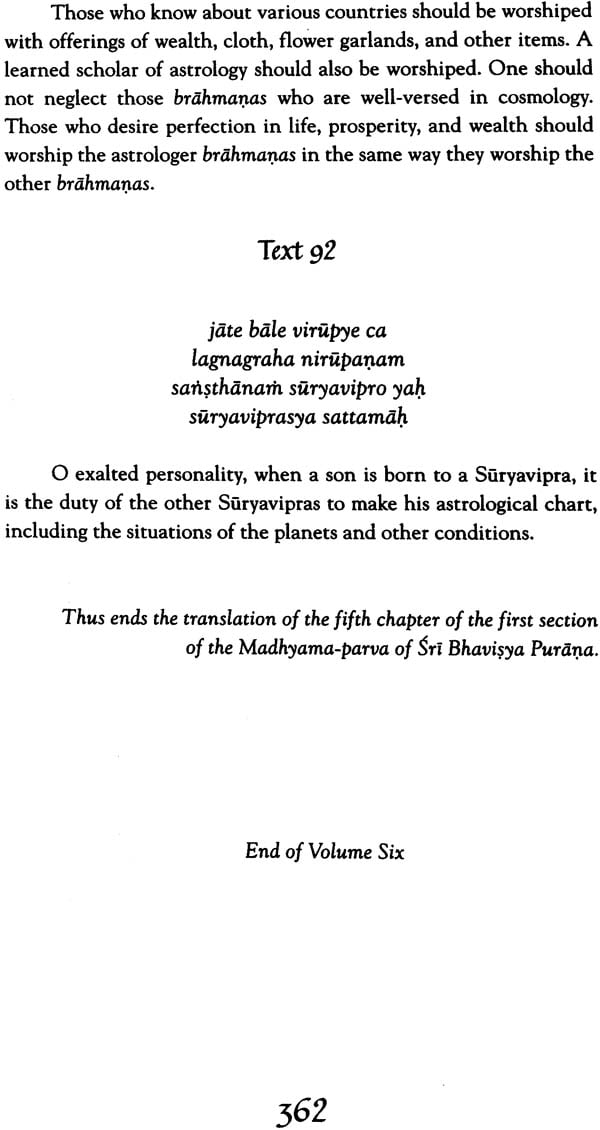
Bhavishya Purana (Set of 6 Volumes) - Incomplete, A Work in Progress
Book Specification
| Item Code: | NAN126 |
| Author: | Sri Krisna Dvaipayana Vedavyasa |
| Publisher: | RAS BIHARI LAL AND SONS |
| Language: | Roman Text With English Translation |
| Edition: | 2007 |
| ISBN: | VolI:8184030150 VolII: 9788184030167 VolIII: 9788184030808 VolIV: 9788184030129 VolV: 9788184030310 VolVI: 9788184030327 |
| Pages: | 2815 |
| Cover: | Hardcover |
| Other Details | 9.5 inch x 7.5 inch |
| Weight | 6.10 kg |
Book Description
Vol-I
This Purana is supremely beneficial, it is the greatest of all literatures, and it enhances one's intelligence. It awards one an exalted reputation, and enables one to achieve the eternal goal of life. All types of religious principles are described in this literature. The faults and good qualities of all kinds of activities are mentioned herein (Chapter 1, texts 79-80)
Apart from this, the compilers of this literature have included many historical incidents and traditional stories. A description of the creation of the three worlds, the various purificatory processes, and ancient histories are found in this great literature (Chapter 1, text 85)
This literature also includes glorification of those who speak on spiritual matters, the rules and regulations for observing various vows, the proper etiquette to be observed by the members of the four asrama, the duties of a student who has just returned after completing his studies at the gurukula, intimate association with women, the procedures for marriage, the characteristics of men, and the characteristics of women. (Chapter 1, texts 86-87)
The Bhavisya Purana is one of the eighteen major Puranas. The specific appeal of this Purana, is that it narrates incidents that will occur in the future, as well as accounts-that happened in the distant past.
In this first volume of Bhavisva Purana, there are no future predictions, but as in all the Puranas, there is much of great interest. In this volume there is an elaborate exposition of the auspicious and inauspicious characteristics of men and women, and in the course of this description, there is much information on Vedic physiognomy.
This volume also contains the beginning of an elaborate description of the significance of each of the days of the fortnight, beginning with the first, or pratipada. And, of course, there are stories to illustrate whatever is being explained and in this volume, there is the very interesting story of how Lord Brahrna's fifth head was severed, and for what reason.
The Vedic understanding is that the gross body of a living entity is manifested according to the condition of the subtle body, or mind.
Thus, the condition of one's gross body indicates the previous mentality of a person, and this process is carried on from one moment to the next. Why does someone have particular bodily features, and what do they indicate?
This is the subtle science that is explained in this volume of the Bhavisya Purana.
The Bhavisya Purana is one of the eighteen major Puranas, as stated in the text of Srimad-Bhagavatam (12.7.23-24): The eighteen major Puranas are the Brahma, Padma, Visnu, Siva, Linga, Garuda, Narada, Bhagavata, Agni, Skanda, Bhavisya, Brahma-vaivarta, Markandeya, Vamana, Varaha, Matsya, Kurma and Brahmanda Puranas.
Later, in the Srimad-Bhagavatam (12.13.4-9), when the number of verses contained I each of these major Puranas is listed, it is said: the Bhavisya Purana (consists of) fourteen thousand five hundred (verses). There are statements in other places, however, that indicate that the Bhavisya Purana contains as many as twenty-six thousand verses. This present edition of the Bhavisya Purana is divided into four parts ? Brahma Parva, Madhyama Parva, Pratisarga Parva, and Uttara Parva. The Brahma Parva consists of two hundred sixteen chapters, the Madhyama Parva consists of sixty-two chapters, the Pratisarga Parva consists of one hundred chapters, and the Uttara Parva consists of two hundred eight chapters.
It is generally understood that the Puranas deal with ancient histories, not only on this planet but on planets throughout the universe. The specific appeal of this Purana, however, is that it narrates incidents that will occur in the future, as well as accounts that happened in the distant past.
Once, during a room conversation in Bombay in April, 1977, Srila Prabhupada was asked about these future predictions:
Tamala Krsna: He says he read a passage of the Bhavisya Maha-Purana written by Vyasadeva three thousand years before foretelling Jesus Christ's presence in the Himalayas in 78 of the Christian era, and his meeting with King Shalamoyi. Are there any other prophecies in the Bhavisya Maha-Purana or in any other scriptures telling more accurately Jesus Christ's birthday?
Prabhupada: Everything is accurate there.
The Bhavisya Purana is not very often quoted by the Vaisnava acaryas in our line. The Bhavisya Purana is referred to several times is The Nectar of Devotion, in relation to Ratha-yatra: A similar statement is there in the Bhavisya Purana, in which it is said, "Even if born of a lowly family, a person who follows the Ratha-yatra car when the Deities pass in front or from behind will surely be elevated to the position of achieving equal opulence with Visnu."
And again: In the Bhavisya Purana there is a statement about observing different ceremonies celebrating the Lord's appearance (birthday) and other transcendental activities. It is said, "My Lord Janardana [Krsna], please let us know the date when Your mother Devaki-devi gave birth to You. If you kindly inform us about this, then we shall observe a great celebration on this date. O killer of Kesi, we are souls one-hundred-percent surrendered unto Your lotus feet, and we wish only to please You with our ceremonies."
In this first volume of Bhavisya Purana, there are no future predictions but as in all the Puranas, there is much of great interest, In this volume there is an elaborate exposition of the auspicious and inauspicious characteristics of men and women, and in the course of this description, there is much information on Vedic physiognomy. As in all Vedic literature, we are not simply dealing with that which is perceivable to our gross senses. There is certainly much being enacted on a very subtle platform at least that is my personal conviction. Such things may be witnessed by us, but their affects upon us cannot be denied. Physiognomy falls into that category.
The Vedic understanding is that the gross body of a living entity is manifested according to the condition of the subtle body, or mind. Thus, the condition of one's gross body indicates the previous mentality of person, and this process is carried on from one moment to the next. Why does someone have particular bodily features, and what to they indicate? This is the subtle science that is explained in this volume of the Bhavisya Purana. This volume also contains the beginning of an elaborate description of the significance of each of the days of the fortnight, beginning with the first, or pratipada. And, of course, there are stories to illustrate whatever is being explained and in this volume, there is the very interesting story of how Lord Braham's fifth head was severed, and for what reason.
This present edition is in response to the many requests for an English edition of the Bhavisya Purana, and it is the first, thus filling a big gap in our library of Vedic literature.
Contents
| Chapter 1. | A description of the Bhrama Parva | 11 |
| Chapter 2. | A description of creation and how the Puranas appeared from the fifth mouth of Brahma | 47 |
| Chapter 3. | The various purificatory rites to be performed by the twice-born. | 99 |
| Chapter 4. | A description of the meaning of om, and the glories of the Gayatri mantra. The qualifications of a Brahmana and the duties of a brahmacari | 127 |
| Chapter 5. | Discussion of auspicious and inauspicious characteristics of women | 197 |
| Chapter 6. | A further explanation of women's characteristics and a discussion of the importance of marriage | 235 |
| Chapter 7. | The eight types of marriage. The characteristics of children born form these eight types of union | 251 |
| Chapter 8. | The methods for examining the good or bad nature of women, and the means for dealing with them | 275 |
| Chapter 9. | The duties of women | 299 |
| Chapter 10. | A description of women's misbehavior | 305 |
| Chapter 11. | The household duties of women | 313 |
| Chapter 12. | Further discussion of the duties of women | 319 |
| Chapter 13. | The behavior of a woman whose husband is away from home, and the behavior of co-wives toward one another. | 341 |
| Chapter 14. | Advice for a neglected wife and the behavior of a wife who is pleasing to her husband. | 353 |
| Chapter 15. | The sacred vow of pratipada | 365 |
| Chapter 16. | The worship of Lord Brahma o Pratipada | 387 |
| Chapter 17. | Further discussion of activities to be performed on pratipada | 425 |
| Chapter 18. | A discussion of puspa dvitiya, wherein a story of Cyavna Muni is narrated. | 435 |
| Chapter 19. | The glories of the day known as asunya-sayana-dvitiya | 465 |
| Chapter 20. | The glories of observing the vow of trtiya | 477 |
| Chapter 21. | The glories of observing the vow of caturthi wherein a story about Vinayaka, Karttikeya, Lord Brahma, and Lord Siva is narrated. | 489 |
| Chapter 22. | A description of the dreams of one who is under the influence of Vinayaka | 507 |
Vol-II
This is the first edition of an English Bhavisya Purana to be published and so naturally it will be of interest to scholars of Vedic literature. As the name implies, this book gives predictions into the future and this is of special interest to one and all. This second volume deals primarily with the worship of the sun-god. While going though this volume, you may become puzzled because the glorification of the sun-god seems to indicate that he is the Supreme Personality of Godhead.
In the chapter summary of Canto Five, chapter twenty-two of Srimad-Bhagavatam, Srila Prabhupada wrote: The sun-god, who controls the affairs of the entire universe, especially in regard to heat, light, seasonal changes and so on, is considered an expansion on Narayana. A similar statement is there is the Bhavisya Purana, in which it is said, "Even if born of a lowly family, a person who follows the Ratha-yatra car when the Deities pass in front or fro behind will surely be elevated to the position of achieving equal opulence with Visnu."
Any act that is performed while chanting this previously-mentioned mantra will turn out successful because all the planets become satisfied. After chanting this mantra while concentrating into water for seven nights, there can be torrents of rain, or else ponds and well can became dry, and deities in the temples of the demigods can shake, or else be attracted or stunned. Indeed, this mantra can attract a man or woman, even if he or she is thousands of miles away (Chapter 27, texts 27-30)
To become an object of love and affection for people in general and to control the king, one should prepare a thumb-sized deity of Ganapati ? If one offers incense made from red sandalwood to the Lord within the heat, who is represented by Ganapati, he will become very fortunate (Chapter 29, text 13)
One who, with faith and devotion, fasts while worshiping Surya on this Saptami, which dispels the reactions to all kinds of sinful activities and awards advancement on the path toward transcendental happiness, will gain relief from the threefold material miseries. (Chapter 61, text 35)
There are eighteen major Puranas, as stated in the Srimad-Bhagavatam (12.7.23-24): The eighteen major Puranas are the Brahma, Padma, Visnu, Siva, Linga, Garuda, Narada, Bhagavata, Agni, Skanda, Bhavisya, Brahma-vaivarta, Markandeya Vamana, Varaha, Matsya, Kurma and Brahmanda Puranas.
The number of verses in each Purana is listed in other verses of the Srimad-Bhagavatam (12.13.4-9): The Brahma Purana consists of ten thousand verses, the Padma Purana of fifty-five thousand, Sri Visnu Purana of twenty-three thousand, the Siva Purana of twenty-four thousand and Srimad-Bhagavatam of eighteen thousand. The Narada Purana has twenty-five thousand verses, the Markandeya Purana nine thousand, the Agni purana fifteen thousand four hundred, the Bhavisya Purana fourteen thousand five hundred, the Brahma-vaivarta Purana eighteen thousand and the Linga Purana eleven thousand . The Varaha Purana contains twenty-four thousand verses, the Skanda Puranas eight-one thousand one hundred, the Vamana Purana fourteen thousand, the Garuda Purana nineteen thousand and the Brahmanda Purana twelve thousand. Thus the total number of verses in all the Puranas is four hundred thousand. Eighteen thousand of these, once again, belong to the beautiful Bhagavatam. This is the first edition of an English Bhavisya purana to be published ad so naturally it will be if interest to scholars of Vedic literature. As the name implies, this book gives predictions into the future and this is if special interest to one all. This second volume deals primarily with worship of the sun-god. While going though this volume, you may become puzzled because the glorification of the sun-god seems to indicate that e is the Supreme Personality of Godhead.
In the chapter summary of Canto Five, chapter twenty-two of Srimad-Bhagavatam, Srila Prabhupada wrote: The sun-god, who controls the affairs of the entire universe, especially in regard to heat, light, seasonal changes ad so on, is considered an expansion of Narayana. He represents the three Vedas-Rg, Yajur and Sama-and therefore he is known as Trayimaya, the form of Lord Narayana. Sometimes the sun-god is also called Surya Narayana. The sun-god has expanded himself in twelve divisions, and thus he controls the six seasonal changes and causes winter, summer, rain and so on. Yogis and karmis following the varnasrama institution, who practice hatha or Astanga-yoga or who perform agnihotra sacrifices, worship Surya Narayana for their own benefit. The demigod Surya is always in touch with the Supreme personality of Godhead, Narayana.
As explained in this volume, the sun-god is not merely one of the demigods. This is confirmed by Srila Prabhupada in his purport to Srimad-Bhagavatam 5.23.3: It is also significant that the predominating deities of even the greatest planets have been of fered their exalted posts because of the very valuable pious activities they performed in previous births. This is indicated herein by the words karma-nirmita-gatayah. For example, as we have previously discussed, the moon in called Jiva, which means that he is a living entity like us, but because of his pious activities he has been appointed to his post as the moon-god. Similarly, all the demigods are living entities who have been appointed to their various posts as the masters of the moon, the earth, Venus and so on because of their great service and pious acts. Only the predominating deity of the sun, Surya Narayana, is an incarnation of the Supreme Personality of Godhead.
At the end of this volume, Surya himself discloses the fact that he is not the Supreme Personality of Godhead. When asked who he worships, he responds that he worships the Supreme Lord, who is his eternal master. It is advised that for achieving good health and a cure for a diseased condition, one should worship the sun-god. With this in mind, let me hope that these words find you in good health.
Contents
| Introduction | 9 | |
| Chapter 23. | The characteristics of men and their interpretation | 13 |
| Chapter 24. | Further characteristics of men and their interpretation | 31 |
| Chapter 25. | Characteristics of men continued | 55 |
| Chapter 26. | The characteristics of women and their interpretation. | 63 |
| Chapter 27. | Glories of worship of Ganapati | 75 |
| Chapter 28. | The procedure for worshiping Ganapati | 85 |
| Chapter 29. | The vow of Siva Caturthi | 95 |
| Chapter 30. | The vow of Naga Pancami | 111 |
| Chapter 31. | The varieties of snakes and their bites | 127 |
| Chapter 32. | Symptoms exhibited by a person who has been bitten by a black cobra | 141 |
| Chapter 33. | A description of the variety of snakes | 149 |
| Chapter 34. | The vow of Naga Pancami | 165 |
| Chapter 35. | The vow of Naga Pancami in the month of Bhadra | 183 |
| Chapter 36. | The completion of the Naga Pancami vow. | 185 |
| Chapter 37. | The glories of Sasthi | 187 |
| Chapter 38. | The truth about varnasrama | 191 |
| Chapter 39. | A doubt whether human society can be divided into social orders. A Brahmana defined | 203 |
| Chapter 40. | The samskaras for a brahmana | 217 |
| Chapter 41. | Divisions of society according to varna | 227 |
| Chapter 42. | Division of society according to varna continued. | 239 |
| Chapter 43. | Introduction to the worship of Karttikeya | 249 |
| Chapter 44. | The glories of worshiping Karttikeya | 251 |
| Chapter 45. | The vow of Saptami and the pastimes of Surya | 255 |
| Chapter 46. | The glories of Surya, the sun-god | 275 |
| Chapter 47. | The procedure for worshiping Surya, and the glories of such worship | 289 |
| Chapter 48. | Ratha Saptami and other vows in relation to Surya | 299 |
| Chapter 49. | Surya's chariot and journey across the sky. | 303 |
| Chapter 50. | Surya's associates and prowess | 317 |
| Chapter 51. | The glories of Surya | 331 |
| Chapter 52. | The procedure for celebrating the chariot festival of Surya | 337 |
| Chapter 53. | The ratha-yatra of Surya and counteracting in influence of inauspicious planets | 359 |
| Chapter 54. | Further description of the ratha-yatra | 373 |
| Chapter 55. | The glories of Surya's ratha-yatra | 381 |
| Chapter 56. | The glories of Ratha Saptami | 393 |
| Chapter 57. | The glories of Surya | 401 |
| Chapter 58. | Brahma discloses to the sages a method for worshiping Surya | 407 |
| Chapter 59. | Conversation between Brahma and Dindi | 415 |
| Chapter 60. | The glories of worshiping Surya | 427 |
| Chapter 61. | Further discussion of worship of Surya | 439 |
| Chapter 62. | The vow of Rahasya Saptami | 455 |
| Chapter 63. | Brahma's instruction to Yajnavalkya | 463 |
| Chapter 64. | Conversation between Brahma and Surya | 485 |
Vol-III
Back of the Book
The Bhavisya Purana is one of the eighteen major Puranas as stated in the text of srimad Bhagavatam (12.7.23-24): The eighteen major Purana are the Brahma Padma, Visnua, Siva, Lingna, Garuda, Narada, Bhagavata, Agni, Skanda, Bhavisya, Brahma-Vaivarta, Markandya, Vamana, Varaha, Matsya, Kurma and Brahmanda Puranas. Later in the Srimad Bhagavatam (12.13.4-9) when the number of verses contained in each of these major puranas is listed it is said; the Bhavisya Puranas (consists of ) fourteen thousand five hundred (verses). This present edition of the Bhavisya Purana is divided into four parts Brahma Parva Madhyama Parva, Pratisarga Parva, and Uttara Parva.
It is generally understood that the Puranas deal with ancient histories not only on this planet but on planets throughout the universe. The specific appeal of this Purana, however, is that it narrates incidents that will occur in the future as well as account that happened in the distant part.
The Bhavisya Purana is one of the eighteen major Puranas. The specific appeal of this Purana is that it narrates incidents that will occur in the future as well as account that happened in the distant past.
Lord Brahma said: Now I will describe that exalted personality who is worshiped by all the demigod including myself Lord Vishnu and Lord Siva. The Vedic understanding is that the gross body of a living entity is manifested according to the condition of the subtle body or mind.
Thus the condition of one gross body indicates the previous mentality of a person and this process is carried on from one moment to the next. Why does someone have particular bodily features and what do they indicate?
This is the subtle science that is explained in this volume of the Bhavisya Purana.
Introduction
The Bhavisya Purana is one of the eighteen major Purana as stated in the text of Srimad Bhagavatam (12.7.23-24): The eighteen major Puranas are the Brahma, Padma, Visnu, Siva, Linga, Garuda, Narada, Bhagavata, Agni, Skanda, Bhavisya, Brahamavaivarta, Markanddeya, Vamana, Varaha, Matsya, Kurma and Brahmanda Puranas.
Later in the Srimad Bhagavatam (12.13.4-9) when the number of verses contained in each of these major Puranas is listed it is said; the Bhavisya Purana (consists of) fourteen thousand five hundred (verses). There are statement in other places however that indicate that the Bhavisya Purana contains as many as twenty six thousand verses. This present edition of the Bhavisya Purana is divided into four part Brahma Parva Madhyama Parva pratisarga Parva and Uttara Parva. The of sixty two chapter the pratisarga Parv consists of one hundred chapter and the Uttara Purva consists of two hundred eight chapter.
It is generally understood that the Puranas deal with ancient histories not only on this planet but on planets throughout the universe. The specific appeal of this Puranas however is that it narrates incidents that will occur in the future as well as accounts that happened in the distant past.
Once during a room conversation in Bombay in April 1977, srila Prabhupada was asked about these future predictions:
Tamala Krsna: He says he read a passage of the Bhavisya Maha Purna written by Vyasadeva three thousand years before Christ foretelling Jesus Christs Presence in there any other Prophecies in the Bhavisya Maha Purana or in any other scripture telling more accurately jesus Christ birthday.
Prabhupada: Everything is accurate there.
And again: In the Bhavisya Purana there is a statement about observing different ceremonies celebrating the Lord appearance (birthday) and other transcendental activities. It is said My Lord Janardana (Krsna) please let us know the date when your mother Devaki devi gave birth to you. If you kindly inform us about this then we shall observe a great celebration on this date. O killer of Kesi we are soul one hundred percent surrendered unto your lotus feet and we wish only to please you with our ceremonies.
The vedic understanding is that the gross body of a living entity is manifested according to the condition of the subtle body or mind. Thus the condition of one gross body indicates the previous mentality of a person and this process is carried on from one moment the next. Why does someone have particular bodily feature and what do any indicate? This is the subtle science that is explained in this volume of this Bhavidya Purana.
This present edition is in response to the many requests for an English edition of the Bhavisya Purana and its is the first thus filling a big gap in our library of Vedic literature.
Contents
| Chapter 65 | The procedure for worshiping the sun-god | 15 |
| Chapter 66 | Interpretation of dream | 29 |
| Chapter 67 | Result of worshiping the sun-god | 37 |
| Chapter 68 | The names of the sun-god | 45 |
| Chapter 69 | Samba cursed by Durvasa Muni | 51 |
| Chapter 70 | Samba cursed by Lord Krsna. The nature of woment. | 57 |
| Chapter 71 | The twelve expansions of the sun-god. | 73 |
| Chapter 72 | Lord Krsna advises Samba to approach Narada Muni | 83 |
| Chapter 73 | Narada Muni travels to Suryaloka | 89 |
| Chapter 74 | Description of the sun-god | 97 |
| Chapter 75 | The glories of Surya | 103 |
| Chapter 76 | Surya wives and their children | 129 |
| Chapter 77 | Description of the worship Surya | 155 |
| Chapter 78 | The vow of Vijaya Saptami | 167 |
| Chapter 79 | Observance of the Nanda-Vrata | 173 |
| Chapter 80 | Observance of the Bhadra-vrata | 181 |
| Chapter 81 | Observance of the Saumya-vrata | 185 |
| Chapter 82 | Observance of the Kamada-vrata | 187 |
| Chapter 83 | Observance of the Putrada vow | 191 |
| Chapter 84 | Observance of the Jayanta-vrata | 197 |
| Chapter 85 | Observance of the vijaya-saptami | 199 |
| Chapter 86 | Observance of the Adityabhimukha-vrata | 201 |
| Chapter 87 | Observance of the Hrdaya-vrata | 205 |
| Chapter 88 | Observance of the Rogaha-vrata | 207 |
| Chapter 89 | Observance of the Mahasveta-vrata | 209 |
| Chapter 90 | The merit of worshiping the sun-god | 215 |
| Chapter 91 | The glories of reciting the Vedic literature | 241 |
| Chapter 92 | The glories of bathing the deity of the sun-god | 263 |
| Chapter 93 | Observing the vow of Jaya saptami | 297 |
| Chapter 94 | Further considerations of the worship of Surya | 277 |
| Chapter 95 | The vow of Apaarajita Saptami | 287 |
| Chapter 96 | The vow of Mahajaya Saptami | 293 |
| Chapter 97 | The vow of Nanda Saptami | 297 |
| Chapter 98 | The vow of Bhadra Saptami | 303 |
| Chapter 99 | The presiding deities of the tithis and nakastras | 311 |
| Chapter 100 | The result attained by worshiping surya | 335 |
| Chapter 101 | The vow of sveta saptami | 353 |
| Chapter 102 | Further description of the vow of Saptami | 361 |
| Chapter 103 | The vow of papanasini Saptami | 371 |
| Chapter 104 | The worship of surya during the two periods of uttrayana and daksinayana | 377 |
| Chapter 105 | The vow of Sarvapti saptami | 385 |
| Chapter 106 | The vow of martanda spatami | 389 |
| Chapter 107 | The vow of Ananta Saptami | 395 |
| Chapter 108 | The vow of the Saptami of the fortnight of the waxing moon in the month of Sravana | 399 |
| Chapter 108 | The vow of the Saptami of the fortnight of the waxing moon in the month of Sravana | 399 |
| Chapter 109 | The vow of the Saptami of the fortnight of the waxing moon in the month of Magha | 403 |
| Chapter 110 | The glories of service rendered to the sun-god | 409 |
| Chapter 111 | The glories of bathing the deity of Suray | 421 |
| Chapter 112 | Suitable offering for the deity of Surya | 427 |
| Chapter 113 | The story of king Satrajita. Surya conversation with Aruna | 439 |
| Chapter 114 | Description of the bhojaka brahmanas | 479 |
| Chapter 115 | The story of Bhadra | 503 |
| Chapter 116 | The Yamadutas instruct the resident of hell | 519 |
Vol-IV
It is generally understood that the Puranas deal with ancient histories not only on this planet but on planets throughout the universe the specific appeal of this Purana however is that it narrates incidents will occur in the future as well as accounts that happened in the distant past.
Contents
| Chapter 117 | Lord Brahma's Instruction to Lord Vishnu on the worship of Surya | 13 |
| Chapter118 | The Turing of Surya's body on the lathe by Visvakarma | 35 |
| Chapter 119 | Prayers of Lord Brahma to Surya | 43 |
| Chapter 120 | Prayers of the demigods and the transformation of Surya's body | 47 |
| Chapter 121 | Derivations of the names of Surya's associates | 75 |
| Chapter 122 | The Vyoma weapon of Surya names of the demigods and Indras and Planetary dimensions | 89 |
| Chapter 123 | Description of Mount Sumeru and its inhabitants | 111 |
| Chapter 124 | Samba worships Surya | 123 |
| Chapter 125 | The auspicious prayer of Surya revealed to to Samba | 135 |
| Chapter 126 | The appearance of the Surya deity to Samba | 141 |
| Chapter 127 | Dimensions of Surya's temples Selection of Land for constructing one's residence | 147 |
| Chapter 128 | Selection of the tree for acquiring wood to carve a deity | 167 |
| Chapter 129 | Characteristics of an auspicious deity of a demigod and the results obtained by worshiping a poorly fashioned deity | 181 |
| Chapter 130 | All the demigods reside within the body of surya | 193 |
| Chapter 131 | Preparations for installing the deity | 201 |
| Chapter 132 | Procedures for performing the bathing ceremony for the deity of Surya | 209 |
| Chapter 133 | The Adhivasana ceremony preceding the installation of the Surya deity | 227 |
| Chapter 134 | The glories of installing a deity of Surya | 251 |
| Chapter 135 | Establishing flags on top the temples of the demigods | 257 |
| Chapter 136 | Samba Brings the Magas from Sakadvipa to Worship the deity of the sun god | 281 |
| Chapter 137 | Samba inquires from Vyasa about the Bhojakas | 311 |
| Chapter 138 | The Marriage of the Bhojas with the Bhojakas | 327 |
| Chapter 139 | The Avyanga worn by Bhojakas | 333 |
| Chapter 140 | The Procedures for worshiping Surya | 341 |
| Chapter 141 | Description of the Bhojakas | 357 |
| Chapter 142 | Instruction of Vyasadeva to Lord Krsna | 365 |
| Chapter 143 | Instruction of Lord Krsna to Narada and Parvata | 375 |
| Chapter 144 | Description of worship able Bhojakas and those not to be worshiped | 383 |
| Chapter 145 | Description of Lord Krsna's Cakra | 395 |
| Chapter 146 | Initiation into the worship of Surya | 405 |
| Chapter 147 | The worship of Surya within a cakra | 421 |
| Chapter 148 | The best method for worshiping Surya | 429 |
| Chapter 149 | Satanika inquires about the merit of worshiping Surya | 439 |
| Chapter 150 | Brahma, Visnu and Mahesa become deluded and then enlightened by Surya | 445 |
Vol-V
The Bhavisya Purana is one of the eighteen major Puranas. The specific appeal of This Purana is that it narrates incidents that will occur in the future , as well as accounts that happened in the distant Past.
In the first volume of Bhavisya Purana there are no future predictions, but as in all the Puranas, there is much of great interest.
In this Volume there is an elaborate exposition of the auspicious and inauspicious characteristics of men and women, and in the course of this Description, there is much information on Vedic physiognomy.
This Volume also contains the beginning of an elaborate description of the significance of each of the days of the fortnight, beginning with the first, or pratipada. And, of course, there are stories to illustrate whatever is being explained and in this volume, there is the very interesting story of how lord Brahma's fifth head was severed, and for what reason.
The vedic understanding is that the gross body of a living entity is manifested according to the condition of the subtle body, or mind.
Thus, the condition of one's gross body indicates the previous mentality of a person, and this Process is carried on forms one moment to the next. Why does someone have particular bodily features, and what to do they indicate?
This is the subtle science that is explained in this volume of the Bhavisya Purana.
Contents
| Chapter 151 | Sarya's form as Vyoma. | 11 |
| Chapter 152 | Surya instructs Brahma, Visnu, and Siva, and awards them benedictions. | 24 |
| Chapter 153 | Surya benedicts Lord Visnu at Salagrama. | 43 |
| Chapter 154 | Inquiries by Satanika to Sumantu . | 52 |
| Chapter 155 | How Surya appeared as the son of Kasyapa and Aditi. | 64 |
| Chapter 156 | Further description of Sarya's appearance. | 75 |
| Chapter 157 | Brahma and Lord Visnu go to visit Lord Siva. Surya appears before them, being pleased by their penance, and displays their universal form. | 82 |
| Chapter 158 | The glories of Surya. | 96 |
| Chapter 159 | The benefits obtained by worshiping Surya. | 100 |
| Chapter 160 | Procedures for worshiping Surya. | 118 |
| Chapter 161 | Further description of the benefits obtained by worshiping Surya. | 146 |
| Chapter 162 | Performing the nakta-vrata for the satisfaction of Surya. | 176 |
| Chapter 163 | Performing the niksubharka-vrata. | 188 |
| Chapter 164 | How a woman should worship Surya. | 194 |
| Chapter 165 | Further description of how a woman should worship Surya. | 200 |
| Chapter 166 | Further prescriptions for worshiping Surya. | 211 |
| Chapter 167 | The benefit of donating cows to Surya. | 217 |
| Chapter 168 | The duties of the Maga. or bhojaka. devotees of Surya. | 219 |
| Chapter 169 | The benefit of serving the devotees of Sarya. | 236 |
| Chapter 170 | The conversation of Garuda and Aruna. | 253 |
| Chapter 171 | Aruna glorifies the worship of Surya. | 261 |
| Chapter 172 | Aruna worships Surya so that Garuda can regain the use of his limbs. | 274 |
| Chapter 173 | Continuation of Aruna's worship of Surya. | 287 |
| Chapter 174 | Further continuation of Arunc's worship of Surya. | 290 |
| Chapter 175 | Conclusion of Aruna's worship of Surya. | 297 |
| Chapter 176 | Aruna invokes the demigods for attaining peace. | 311 |
| Chapter 177 | Further invocations for peace. | 324 |
| Chapter 178 | Description of the smarta religion. | 340 |
| Chapter 179 | Description of the samskaras. The classification of unmarried girls. | 352 |
| Chapter 180 | Description of the various sraddha ceremonies. | 376 |
| Chapter 181 | The duties of a brahmana. | 387 |
| Chapter 182 | Further description of the sraddha ceremonies. | 407 |
| Chapter 183 | The importance of faith. The importance of the spiritual master. The importance of cows. | 416 |
Vol-VI
The Bhavisya Purana is one of the eighteen major Puranas. The specific appeal of This Purana is that it narrates incidents that will occur in the future , as well as accounts that happened in the distant Past.
In the first volume of Bhavisya Purana there are no future predictions, but as in all the Puranas, there is much of great interest.
In this Volume there is an elaborate exposition of the auspicious and inauspicious characteristics of men and women, and in the course of this Description, there is much information on Vedic physiognomy.
This Volume also contains the beginning of an elaborate description of the significance of each of the days of the fortnight, beginning with the first, or pratipada. And, of course, there are stories to illustrate whatever is being explained and in this volume, there is the very interesting story of how lord Brahma's fifth head was severed, and for what reason.
The vedic understanding is that the gross body of a living entity is manifested according to the condition of the subtle body, or mind.
Thus, the condition of one's gross body indicates the previous mentality of a person, and this Process is carried on forms one moment to the next. Why does someone have particular bodily features, and what to do they indicate?
This is the subtle science that is explained in this volume of the Bhavisya Purana.
Contents
| Chapter 184 | Duties of brahmanas. Atonements for various faults. Things to be avoided. Vows to be observed. Periods of contamination upon the death of a relative. | 11 |
| Chapter 185 | The glories of the worship of Surya. The duty of receiving guests and worshiping brahmanas. | 25 |
| Chapter 186 | The correct procedures for giving charity, especially to a brahmanas. Further glories of the worship of Surya. | 34 |
| Chapter 187 | A description of sinful activities and their consequences. Classes of sinful acts. | 54 |
| Chapter 188 | Further description of sinful people and their sinful acts. | 60 |
| Chapter 189 | The paths to the abode of Yama traversed by sinful and pious people. | 69 |
| Chapter 190 | The vow of Saptami. | 79 |
| Chapter 191 | Interpretation of dreams. | 85 |
| Chapter 192 | Further description of the vow of Saptami. | 93 |
| Chapter 193 | Duties of bhojaka brahmanas. Further considerations concerning the vow of Saptami. | 100 |
| Chapter 194 | The offering of flowers and incense to Surya. Further consideration of the worship of Surya. | 119 |
| Chapter 195 | Conversation between Bhisma and Vyasadeva concerning the worship of Surya. | 127 |
| Chapter 196 | The mantras for worshiping Surya. | 136 |
| Chapter 197 | Conversation between Lord Kesava and Brahma regarding the mantras for worshiping Surya. | 145 |
| Chapter 198 | Worshiping Surya within a mandala. | 152 |
| Chapter 199 | The worship of Surya in the form of Vyoma. | 157 |
| Chapter 200 | Further considerations of the worship of Surya. | 163 |
| Chapter 201 | The supreme worship of Surya. | 171 |
| Chapter 202 | The glories of worshiping Surya. | 177 |
| Chapter 203 | Description of the twelve Saptamis. | 186 |
| Chapter 204 | Conclusion of the discussion of the vow of Saptami. | 197 |
| Chapter 205 | Description of brahmanas who are worthy of being fed, and those who are unworthy. | 202 |
| chapter 206 | The story of Kauthumi and Hiranyanabha. | 227 |
| Chapter 207 | The worship of Surya along with his energies. The procedure for hearing the Puranas and the etiquette for honoring the speaker. | 241 |
| | ||
| Chapter 1 | The subject matters of the Puranas. Discussion of the four objectives of human life. The duties of all human beings. | 295 |
| Chapter 2 | Creation of the universe and its characteristics. | 307 |
| Chapter 3 | Description of the planetary systems. | 315 |
| Chapter 4 | Description of jambudvipa. Situation of the planets of the universe. | 323 |
| Chapter 5 | The glories of brahmanas. The twenty-six faults to be avoided. | 335 |
